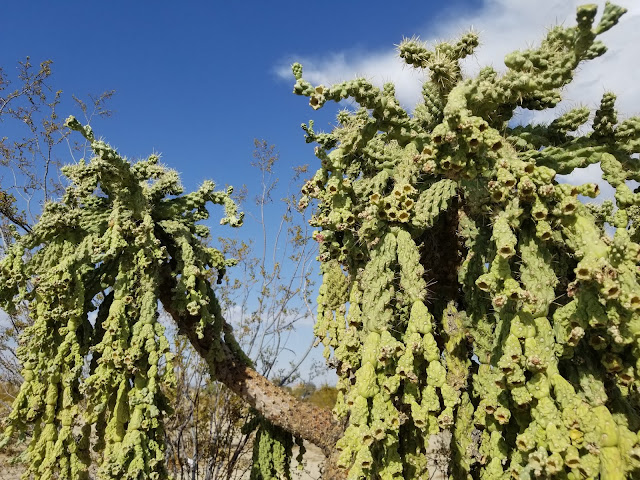Botanical Name: Cylindropuntia Ramosissima
Common Names: Diamond Cholla
Alternate Botanical Names: Opuntia Ramosissima
Visual Characteristics: Mature plants generally are erect and multi branched. Trunk areas are dark, hardened, and have bark like features, as do most Cylindropuntia. Setting it apart from its relatives are terminal branches with numerous slender segments. All Cholla have raised fleshy bumps on their flesh, termed Tubercles. Further differentating, Diamond Cholla does not have raised tubracles, a trait unique among the Genus. Spectacular blooms of various colors occur in spring. White, spiny, burr like fruits follow.
Visual Characteristics: Mature plants generally are erect and multi branched. Trunk areas are dark, hardened, and have bark like features, as do most Cylindropuntia. Setting it apart from its relatives are terminal branches with numerous slender segments. All Cholla have raised fleshy bumps on their flesh, termed Tubercles. Further differentating, Diamond Cholla does not have raised tubracles, a trait unique among the Genus. Spectacular blooms of various colors occur in spring. White, spiny, burr like fruits follow.
Native To 29 Palms: Yes
Native To Adjacent Regions: Yes
Native To Adjacent Regions: Yes
Occurance In Neighborhoods: Common
Occurance In Rural Areas: Common
Use by Indigenous Cultures: Native tribes consumed the buds, and also cured them for trade. Meetings of different communities would bring about exchanges of food and supplies not available without bartering.
Use by Indigenous Cultures: Native tribes consumed the buds, and also cured them for trade. Meetings of different communities would bring about exchanges of food and supplies not available without bartering.
Sentiments: Ancient tidings transcend writings, timeworn tides traverse earths biding, binding only by the blade, inside our earth the roots are laid older earthly binds and bidings.























